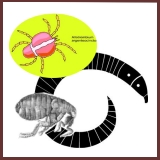- Home
- Maine Coon Cat Health
- Cat Parasites
Cat Parasites and Pests:
Fleas, Ticks, Worms, and
What You Need To Know
Cat parasites and pests can be so frustrating! Between fleas, ticks, worms, and mites there are more than a few pests to worry about.
Let's review all of those, with a special focus on getting rid of fleas on cats.

This is definitely one of the least pleasant aspects of cat care. But, by learning about cat parasites, along with their signs and symptoms, you'll be a step ahead in ensuring the health of your friend.
All parasites are a nuisance, and some even carry deadly diseases.
Fleas on Cats
The first and most common of the cat parasites is fleas. If you find yourself with a flea problem in your house, you are not alone. Many pet owners become plagued by these persistent parasites every year. It happened to us, even though our cats are indoors.
If you haven't seen it yet, take a look at these 8 little-known facts to use against fleas. It's key to get the inside track on these lovely houseguests. There are some interesting tricks that will be useful in their elimination.
They are more than just pests, though. A severe infestation on a small kitten, ill, or elderly cat can result in anemia.
This can be deadly without emergency veterinary treatment, such as blood transfusions or iron supplements. Fleas carry other dangers as well, the most common being tapeworms.
The tapeworm develops inside the flea, and when the flea is swallowed by a cat during grooming, the tapeworm is released and attaches itself inside the cats intestinal tract. The best way to prevent these parasites in cats is to prevent fleas.
Signs of Fleas in the House:
Your pet will scratch himself, of course. Also, there will be tiny black dust-like flecks where the cat sleeps, and in his fur. It is flea feces (composed of dried blood), mixed with eggs, and when you comb your cat you can look for this as a definite sign.
Our multi-point guide to getting rid of fleas in the home offers a solid plan to eliminate fleas from the house.
As part of a natural approach to getting rid of fleas, vinegar proves to be a useful tool. Learn about the ways that vinegar can be used on fleas and you'll be one step ahead.
Getting rid of fleas can be really hard.
That's why we've created an effective, easy to follow action plan. Because we know you want to stop searching the internet - you just need the fleas gone, now! You can click here to check it out.
What to Do
Take a proactive approach, immediately. The reason for this lies in the life cycle of a flea. They multiply at an amazing rate. Females can lay around 50 eggs a day, and when those hatch, they will do the same.
They usually only stay on a pet long enough to feed. For every flea you see, there could be hundreds or even thousands more elsewhere in the home.
Naturally, there are many different flea treatment products on the market. Flea bombs work well, though they don't kill fleas in the pupal, or cocoon, stage of development.
There are a variety of flea shampoos available. They are really helpful for giving your cat some immediate relief. Although any shampoo will kill fleas if left on for 10 minutes, most cats won't stay lathered for that long!
A combination of bathing, bombing, spraying and vacuuming will help lower the flea population immediately.
But, if there is just one flea left, it will start all over again. That is where the topical flea medications come in.
Flea Treatments
We now use Advantage Flea Control at our house on all the pets, even though only the dog goes outdoors.
She could bring just one flea in the house, and it would find the cats. We've been very satisfied with it, and very happy with the peace of mind it brings.
The advantage to this kind of approach is that you can eliminate other cat parasites, such as ticks and/or mosquitos, as well. Other brands include:
- Frontline Plus Flea and Tick
- Revolution Flea Tick and Heartworm
- Promeris Tick and Flea Control
- Frontline Top Spot
- TriForce For Fleas, Ticks and Mosquitos
Oral Medications:
- Capstar
- Program
Our top picks for flea products provides a variety of the most effective and safe products for you to compare.
Cat Parasites: Ticks on Cats
Ticks are cat parasites that are especially dangerous, since they can carry Lyme Disease.
It's actually the Deer Tick, which is extremely small and nearly impossible to see, that can carry this disease. The larger and more common Dog Tick doesn't. Lyme Disease, left untreated, is deadly.
Cat Parasites: Lyme Disease in Cats
There is currently no preventative vaccine for Lyme Disease in cats. Signs and symptoms of infection include fever, lameness, lethargy, and stiff joints. Cats don't develop the tell-tale rash that people do.
It's not exactly practical to do a thorough "tick-check" on a cat regularly, so that's another reason to use one of the Flea and Tick Treatments regularly. Prevention is the best protection.
Cat Parasites: Worms in Cats
Tapeworms were mentioned above. They attach to the inside of the intestines, and the best way to prevent them is to prevent fleas. A sign of tapeworms in cats is seeing tiny rice-sized portions of the worm come out of the cats' bottom. They are egg sacs, and they are often moving.
Other common worms in cats include roundworms, which are diagnosed with a fecal test. Hookworms and ringworms pose the additional complication of being transmittable to people.
Heartworms, which most people associate with dogs, are also a danger to cats, and fatal as well. Just one adult heartworm can cause serious problems to their small heart. Unfortunately, often the first symptom of infection is sudden death.
Heartworms are transmitted by mosquitoes, and interestingly, indoor cats are at a higher risk of complications if infected. This is because outdoor cats develop a slight immune response.
There is no safe treatment available for cats with adult heartworms, so prevention is very important. There are a few heartworm prevention treatments available, such as Revolution, Interceptor, and Heartguard for Cats.
Cat Parasites: Ear Mites
These pesky and itchy critters are hard to miss. A cat with ear mites will itch, a lot. He may ever shake his head, too. It must be maddening for him to feel all those mites crawling around in his ear! There may also be a yucky dark build-up.
Fortunately, it's relatively easy to treat. The ear needs to be cleaned, carefully. If you're worried about damaging the ear canal, you may want to ask the vet to do it. Then it's a matter of applying liquid treatment in the ear until they're gone.
If you are dealing with internal parasites, worms, mites or other issues you may like to check out Amazon's selection of treatments for cat parasites and worms. Amazon regularly offers a quality selection with reasonable prices.
Always remember to check with your vet with any cat parasite concerns. The information on this page is not intended to replace the advice of a veterinarian. It is here as a starting point, or basic overview.
Cat parasites are definitely unpleasant. But by being aware of them, their signs, and knowing our preventative options, we can keep our feline friends fit for life!
Taking Back Your Home:
For a multi-faceted approach to fleas, we've found that using effective and reliable flea products was key.
There are many products on the market. From flea bombs, sprays & shampoos, medications, combs and more it can be daunting to find the best products.
You can visit our Top Picks Pet Flea Products to compare some of the most effective products on the market for getting rid of cat parasites.
« Back to Maine Coon Health





